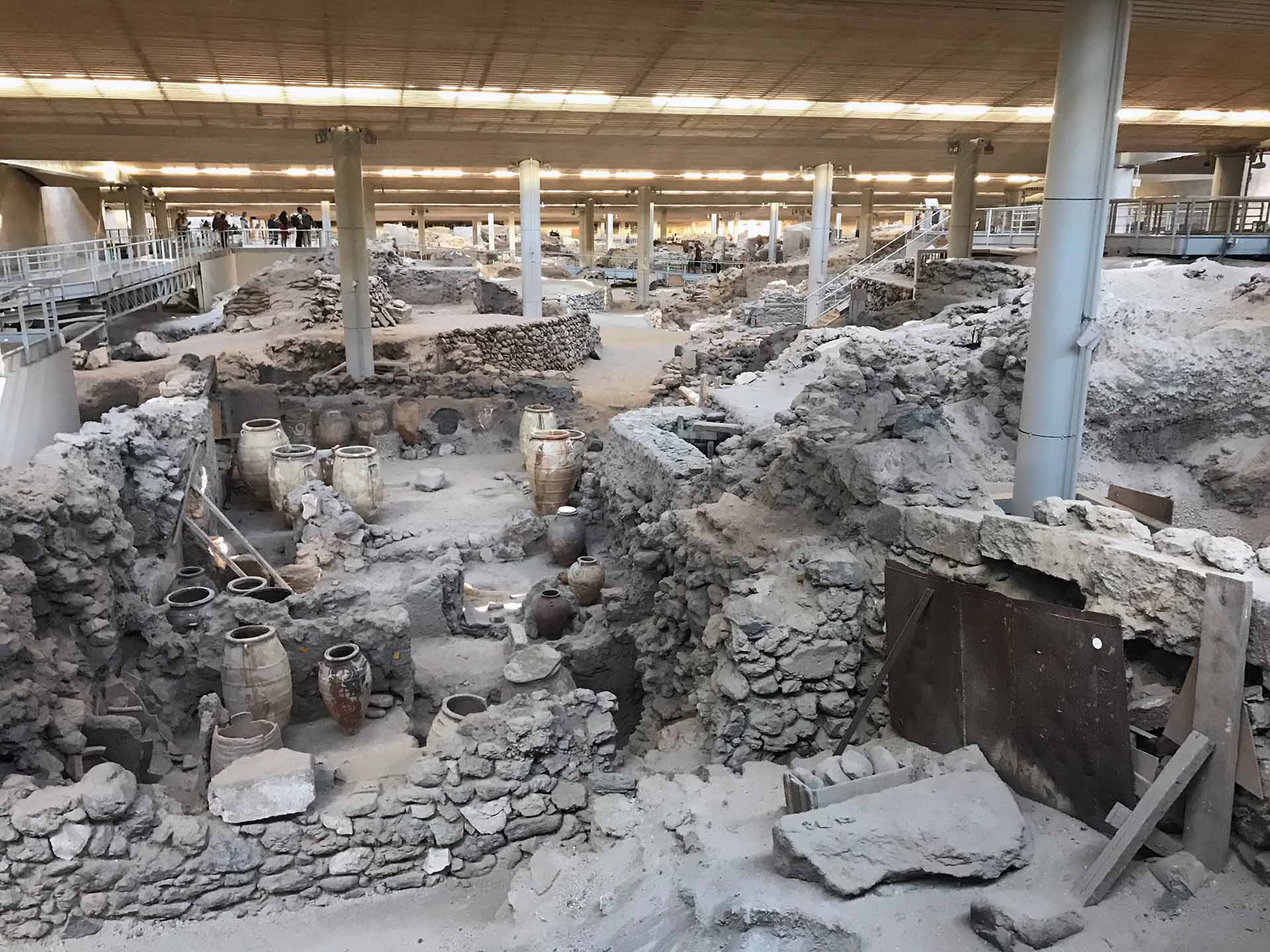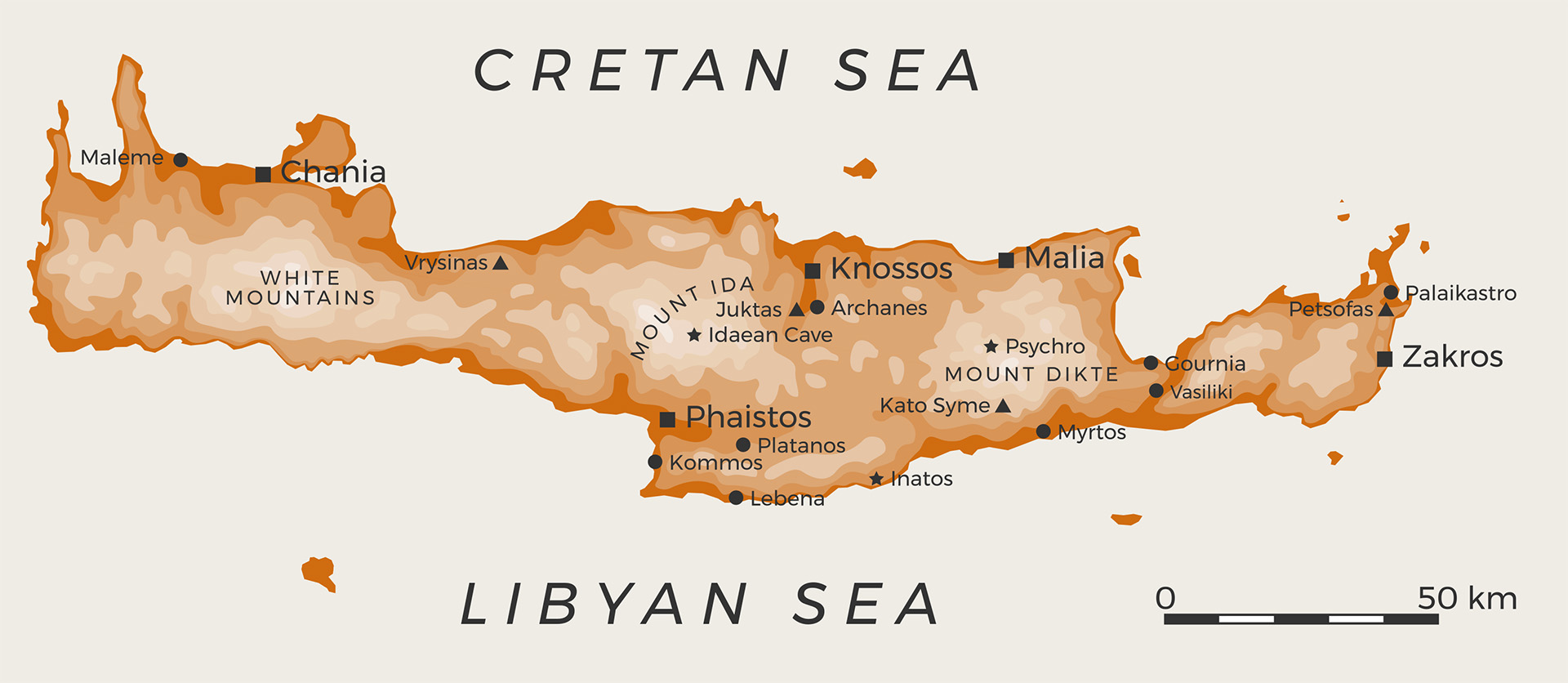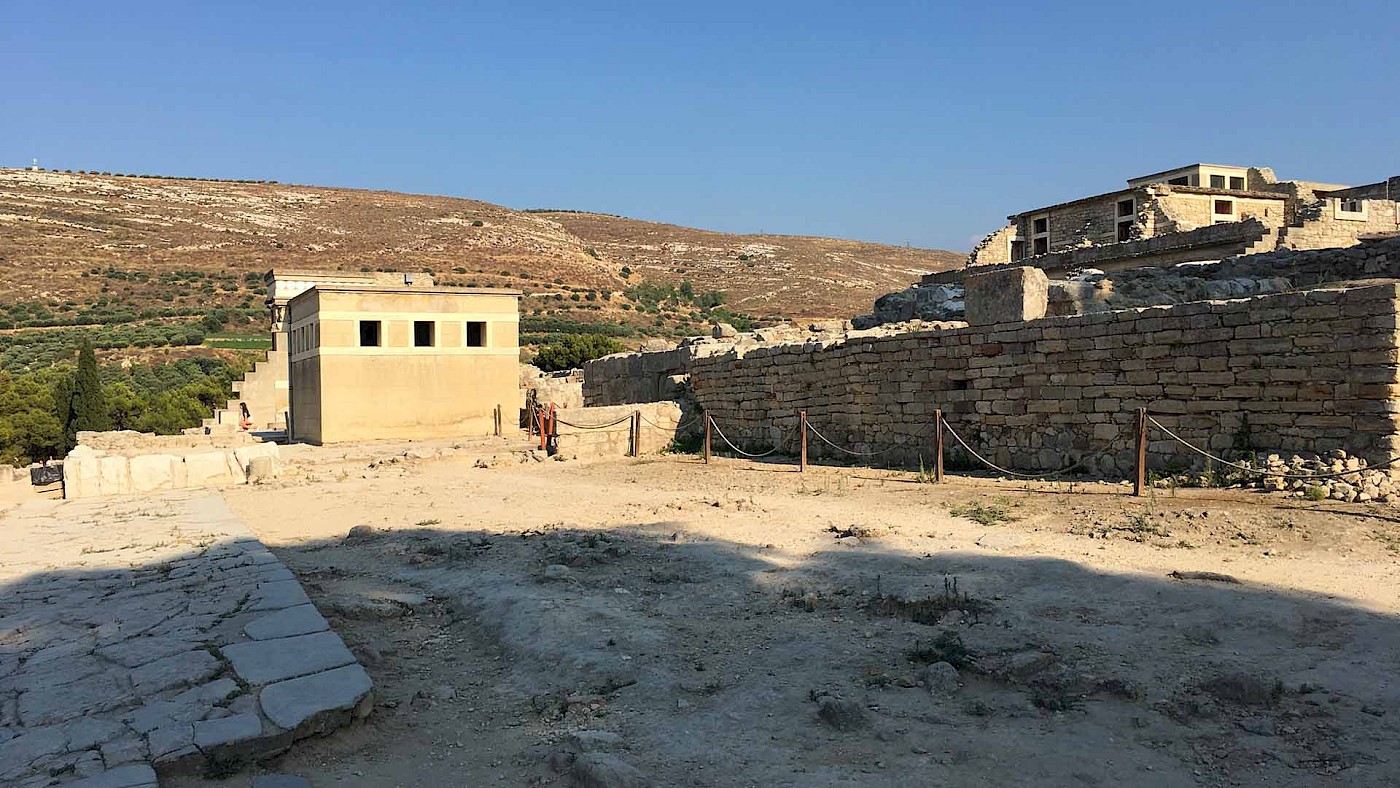A few weeks ago, my wife and I were in Crete. We travelled around the island and visited several archaeological sites. As a result, I have plenty to write about, and I figured an introductory article would be useful. Rather than attempt to treat the island’s entire history in a single article, I will focus on Crete in the Bronze Age (ca. 3100 to 1000 BC).
Few realized Greece even had a noteworthy Bronze Age before the nineteenth century. Certainly, the ancient Greeks told stories of a bygone Age of Heroes, in which men fought for control over the cities of Thebes and Troy, and characters like Heracles performed heroic feats. Greeks of the historic era (after ca. 700 BC), like the travel-writer Pausanias (AD 110-180), were familiar with ruins of ancient cities that featured massive “Cyclopean” walls and which they believed dated back to that earlier era.
Also, in the modern era, places and objects were discovered that didn’t fit well with the ancient Greece of the Classical age, such as magnificent underground tombs built from stone. Only in the later nineteenth century did people start to systematically investigate the archaeological evidence of the pre-Classical era in Greece. And in that story, the name of Heinrich Schliemann looms large.
Searching for heroes
Heinrich Schliemann (1822-1890) was a German entrepreneur with a fascination for the Trojan War. When this fascination started is a little unclear. Schliemann claimed that he’d been given a copy of the Iliad at a young age and had proclaimed, at the age of seven, that he would find the city of Troy. But Schliemann was prone to, let’s say, exeggaration, and much of what he tells us about his personal history should be taken with a grain of salt (see e.g. the books by Wood and Cline in the further reading).
In the 1860s, Schliemann developed a serious interest in locating and excavating Troy, the legendary city from the Iliad. In Turkey, he met an Englishman, Frank Calvert, who’d been doing research in the northwest region and suggested to Schliemann that he dig at Hissarlik, which he had identified as the likely site of ancient Troy. Excavations started in 1871 and Schliemann, who was a rank amateur, destroyed a lot of evidence on the site in order to reach the deepest (and therefore oldest) layers first. As time went on, he improved, but controversy would follow him.
The excavations at Hissarlik revealed a large and prosperous town from the second millennium BC, with impressive fortifications. The layout of the site and its proximity to landmarks mentioned by Homer reinforced the notion that this was indeed the Troy from legend. A large amount of gold objects were unearthed in 1873 which Schliemann was quick to name “Priam’s Treasure”, after the Trojan king who played an important role in the Homeric epic. When Schliemann tried to smuggle the treasure out of the country, the Turkish government revoked his licence to excavate. The treasure wound up in Germany and was eventually seized by the Russians; it’s now in the Pushkin Museum in Moscow.
Schliemann decided next to excavate in Greece to find evidence for the existence of the Age of Heroes. In 1876, he started digging at Mycenae, the city from which Agamemnon, the supreme leader of all the Greeks in the Iliad, had ruled. He made many discoveries here, including the fabled “Mask of Agamemnon” (which predates the supposed hero’s floruit by a few centuries), but most importantly, he demonstrated the existence of an advanced civilization in Greece that predated the more familiar age of the Classical Greek city-states.
Enter Arthur Evans
Towards the end of the nineteenth century, British archaeologist Arthur Evans bought some artefacts in Athens that featured a strange type of writing. He believed it to be Cretan and travelled to the island. Some excavations had already been conducted at Knossos, the fabled home of the mythical king Minos, whose wife Pasiphae had given birth to the half-man, half-bull creature known as the Minotaur. Evans grew convinced that Knossos was a site worth investigating further and he bought the land.
Crete, however, was still in the hands of the Ottoman Empire and the situation was growing volatile. When Crete became an independent republic in 1899, the path was cleared for Evans to excavate at Knossos. The work started in 1900. Inspired by Schliemann’s discoveries on the mainland, Evans believed initially that he would find a Mycenaean palace. But soon, the material he unearthed was different in character and clearly older than what had been discovered on the mainland. This, Evans concluded, was a civilization that predated the Mycenaean one on the mainland.
A large structure was revealed on the site that Evans dubbed a “palace”. This interpretation is not without its issues, as I’ll discuss in a forthcoming article. The ground plan of the palace had a maze-like structure, Evans believed, and it reminded him of the Labyrinth where King Minos had imprisoned the Minotaur. As a result, Evans decided to name the Bronze-Age civilization on Crete “Minoan”, and we’ve been stuck with this name – for better or for worse – ever since.

Evans also discovered further evidence of writing, and was able to distinguish two different scripts: Linear A and Linear B. Evans realized that Linear A was the older of the two, with the younger script, Linear B, having been adopted by the Mycenaean Greeks of the mainland. Around 1450 BC, most of the Minoan palace sites were destroyed, but Knossos remained in use. Linear B tablets are found in large numbers at the site, suggesting that the Mycenaeans from the mainland perhaps took control of the island and used Knossos as a kind of administrative centre (but see the discussion further below for details).
In the 1950s, Michael Ventris discovered that Linear B, the script of the Mycenaeans, was used to write Greek. The Mycenaeans were thus the ancestors of the later Classical Greeks. But Linear A was not deciphered. Both scripts are syllabic (i.e. a symbol represents a syllable, like tri or de or sa), and the general assumption is that the sounds of the Linear A symbols were probably the same or similar as in Linear B. As a result, we’ve been able to comprehend parts of texts written in Linear A. Many words are still unclear, but some personal and place names (like I-DA for Mount Ida) are easily recognized.
It’s still not clear what language the Minoans spoke. It features traits characteristic of both Indo-European and Semitic languages. Unfortunately, there’s too little material at the moment to reliably reconstruct to the language. Unless a large cache of Linear A texts is unearthed, we may never discover what language they spoke or how it relates to others. The only thing we know for sure is that they didn’t speak Greek. From the historic era, we know that there were Eteocretans (“True Cretans”) on the island, who left a few inscriptions written in the Greek alphabet that are incomprehensible, and who may have been descendants of the Minoans. The language appears to have died out by the third century BC.
The Aegean Bronze Age
Despite the existence of different forms of writing, the Aegean Bronze Age is usually referred to as “prehistoric”, as the available texts are relatively few and mostly limited to inventories and other administrative texts, as well as a few religious texts. Some prefer to call the Aegean Bronze Age “protohistoric” to acknowledge the fact that there was some level of writing, and that there are literary tales purported to deal with the period.
Archaeologists rely on relative chronology to establish sequences of events. The chronology of the Aegean Bronze Age was developed in the later nineteenth and early twentieth centuries, when civilizations were believed to go through three stages: rise, flowering, and fall. The Bronze Age is therefore also divided into three parts, namely Early, Middle, and Late. Absolute dates are attached to these large periods using synchronisms from ancient Egypt, using ancient king lists.
The different period themselves are subdivided according to region: for example, the Early Bronze Age on Crete consists of differently numbered phases of “Early Minoan”, while on the mainland it’s referred to as “Early Helladic”. The Late Helladic period, i.e. the Late Bronze Age on the Greek mainland, is sometimes referred to simply as “Mycenaean”. There is regional variation with regards to periodization: e.g. Middle Cycladic II isn’t the same as Middle Minoan II, and Late Helladic III isn’t necessarily identical to Late Minoan III. Furthermore, some sites seem to skip certain periods entirely, and at other sites, a more detailed periodization is necessary (e.g. Late Helladic IIIB1 and IIIB2 in the Argolid).
Scientific dating methods are also used to provide some anchor points. One difficult issue needs to be addressed here. A key event in the Bronze Age is the eruption of Thera (Santorini), an island in the Cyclades (during the Cretan ceramic phase Late Minoan IA). Archaeologists dated the eruption to the late sixteenth century BC. But radiocarbon dates for the eruption point to a date in the late seventeenth century, between 1660 and 1613 BC, with the subrange of 1639-1616 BC deemed to be the most likely. You may have seen this latter date summarized in some publications as ca. 1628 BC.

This means that there are two conflicting chronologies for the Aegean Bronze Age. The “low” chronology postulates that Thera erupted in the late sixteenth century, while the “high” one prefers a date a century earlier. If you’ve read any books on the Bronze Age, this explains why some authors have the Late Bronze Age start in ca. 1700, while others date it to 1600 or even 1550 BC. Since all of the chronologies in the Aegean are tied together, it also affects dates on the mainland: the Mycenaean Shaft Graves will be dated to the seventeenth century by some, but to the sixteenth century by others.
In his chapter on the eruption of Thera in The Oxford Handbook of the Bronze Age Aegean, edited by Eric Cline, Sturt Manning concludes (p. 469):
The date of the great eruption of Thera Santoniri thus remains for the present an unsolved question. The arguments on both sides reflect a clear clash of academic cultures and generations.
In other words, it’s a matter of time before the radiocarbon dates for the Thera eruption are widely accepted. Problems like these are a reason why archaeologists tend to prefer relative chronologies rather than an absolute one, since just dating something to Late Minoan IA is easier than saying something dates to ca. 1650 BC (or whatever). If only absolute dates are used, it can become confusing when the author hasn’t made clear which absolute chronology – high or low – they used.
The island of Minos
For Crete, another relative chronology has been proposed that focuses on the island’s most distinguishing features, namely its “palaces”. This system groups some of the standard periods (essentially ceramic phases) together to create a new system that looks as follows:
- The Prepalatial period (Early Minoan IA to Middle Minoan IA), ca. 3100-1925/1900 BC. This period encompasses the entire Early Bronze Age (third millennium BC) and the beginning of the Middle Bronze Age.
- The Protopalatial or “Old Palace” period (Middle Minoan IB to Middle Minoan II), ca. 1925/1900-1750/1700 BC.
- The Neopalatial or “New Palace” period (Middle Minoan III to Late Minoan IB), ca. 1750/1700-1470/1460 BC. Sometimes this period is extended downwards to still include the period during which Knossos was the only palace still in use on the island (see below), but this can be confusing.
- With Late Minoan II starts the “Final Palace” period; you may encounter references to “Monopalatial” as Knossos seems to have been the only major palatial centre that continued to exist after the destructions that marked the end of the Neopalatial period. For an idea of the differences in interpretation, compare, for example, Hallager 2010, pp. 149-151; MacDonald 2010, pp. 539-540.
- The final destruction of the palace at Knossos marks the start of the “Postpalatial” period in Crete, which extends down to ca. 1000 BC (i.e. the Subminoan ceramic phase), the very end of the Bronze Age. The exact date is a point of contention: it’s either Late Minoan II, IIIA or IIIB. Most writers now date the final destruction to before Late Minoan IIIB, with e.g. John C. McEnroe favouring a date in early Late Minoan IIIA2, or ca. 1360 BC (see McEnroe 2010, pp. 118, with references).
The Protopalatial period is when most of the palaces were built. Because archaeologists have been reluctant to dig underneath the extant remains of the palaces, we know relatively little about the early development of these sites. What is clear is that at the end of the period, in ca. 1700 BC, many of the palaces were severely damaged by a powerful earthquake that was not related to the Thera eruption. The palaces were rebuilt and flourished throughout the Neopalatial period. Most of the visible remains of the Minoan palaces date from this period, which marked the zenith of Minoan civilization.
At the end of the Neopalatial period (end of Late Minoan IB), the palaces at Phaistos, Zakros, and Mallia were destroyed, this time apparently at the hands of humans. From Late Minoan II onwards, only Knossos appears to have remained in use and seems to have formed the administrative centre for what are traditionally assumed to have been Mycenaeans from the mainland, who are thought to have conquered the island. Conventionally, the absolute date you’ll find referenced most often for this supposed Mycenaean takeover is ca. 1450 BC, but it might date a little earlier (or later), depending on your interpretation. In any event, large numbers of Linear B tablets have been unearthed at Knossos that date from this “Monopalatial” period (which many regard as part of a “Final Palatial” period).

However, whether the destructions at the end of Late Minoan IB were the work of the Mycenaeans is not clear. The destructions are so extensive and found all over the island, that they appear more likely to be the result of local upheavals, perhaps even an internal uprising against the extant socio-political system. The Mycenaeans may have exploited this situation and took control of the weakened island. However, it should be noted that the use of “Minoans” and “Mycenaeans” is problematic, as we don’t know if these peoples “saw themselves as two distinct ethnic groups or used any of these symbols (or, indeed, language) to express ethnic difference” (Preston 2010, p. 312).
Toward the end of the Bronze Age, around ca. 1200 BC (end of Late Minoan IIIB), there were large upheavals in the eastern part of the Mediterranean that are still not fully understood. The evidence is conveniently summarized by Eric Cline in his book 1177 BC: The Year Civilization Collapsed (2014). Briefly, the Mycenaean palaces on the mainland were destroyed and in Crete and elsewhere we see that people moved away from the coast to smaller refuge sites, often in mountainous or otherwise inaccessible terrain. The Hittite Kingdom in Anatolia disintegrated, the city-state of Ugarit was destroyed, and Egypt fought off waves of so-called “Sea-Peoples”. It essentially marked the end of the Bronze Age and the start of what has been termed a “Dark Age” (see also Matthew Lloyd’s article).
Closing remarks
In this article, I’ve focused mostly on the archaeological history of the Bronze Age and ran you through the chronology and its problems. Hopefully, this will serve as a useful handhold for the articles that are yet to come that deal with Crete and the Minoan civilization in particular.
You can look forward to articles about the palaces at Knossos, Phaistos, and Zakros, as well as articles on other important sites (such as the Minoan town of Gournia) and specific objects from the archaeological museum at Iraklion. Naturally, I’ll also explore the rich mythology associated with the island.
The plan is also to do a few videos about Crete. As always, there are plenty of plans, but not always enough time! If you want to support Ancient World Magazine, please consider becoming a patron. Your support will enable us to do more, including actually paying our contributors. You can help us out for as little as $2 a month. Thank you.
Further reading
- John Chadwick, The Decipherment of Linear B (1967, 2nd edition).
- Eric H. Cline (ed.), The Oxford Handbook of the Bronze Age Aegean (2010).
- Eric H. Cline, 1177 BC: The Year Civilization Collapsed (2014).
- Eric H. Cline, The Trojan War: A Very Short Introduction (2013).
- Oliver Dickinson, The Aegean Bronze Age (1994).
- Erik Hallager, “Crete”, in: Cline 2010, pp. 149-159.
- Colin MacDonald, “Knossos”, in: Cline 2010, pp. 529-542.
- John C. McEnroe, Architecture of Minoan Crete: Constructing Identity in the Aegean Bronze Age (2010).
- Laura Preston, “Late Minoan II to IIIB Crete”, in: Shelmerdine 2008, pp. 310-326.
- Donald Preziosi and Louise A. Hitchcock, Aegean Art and Architecture (1999).
- Curtis Runnels and Priscilla M. Murray, An Archaeological Companion and Guide to Greece Before History (2001).
- Cynthia W. Shelmerdine (ed.), The Cambridge Companion to the Aegean Bronze Age (2008).
- Michael Wood, In Search of the Trojan War (1996, revised edition).
